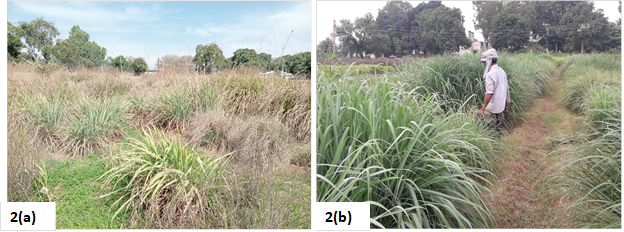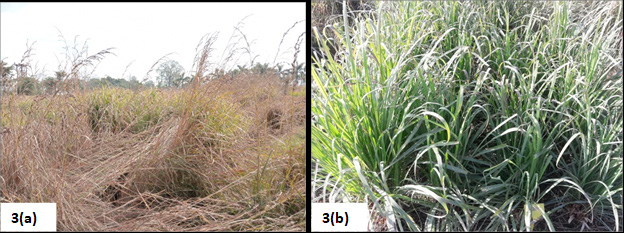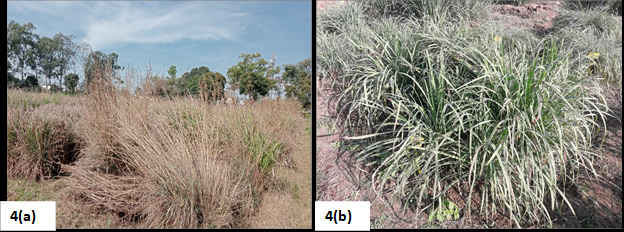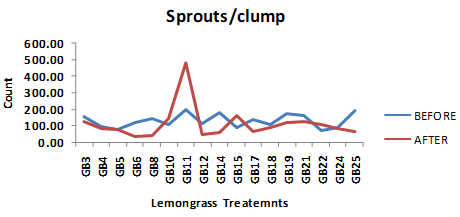Journal of
eISSN: 2572-8466


Research Article Volume 9 Issue 2
Plant Science and Agrotech Division, CSIR – Indian Institute of Integrative Medicine (IIIM), India
Correspondence: Sougata Sarkar, Plant Science and Agrotech Division, CSIR – Indian Institute of Integrative Medicine (IIIM), Canal Road, Jammu -180001, India
Received: February 28, 2022 | Published: March 21, 2022
Citation: Sarkar S, Verma I, Thapa PS, et al. Impact of total lockdown due to COVID19 on the agro-economic traits of lemongrass. J Appl Biotechnol Bioeng. 2022;9(2):25-31. DOI: 10.15406/jabb.2022.09.00281
The COVID19 pandemic has inflicted unprecedented global unrest to every sector of mankind. Likewise, the research and development sector had its own share of disturbances due to the complete lockdown condition for a year. During this period, minimum or no activities could be carried out in the lemongrass trial and the treatments were left uncared for a year. Comparative analyses in seventeen lemongrass treatments were carried out to understand the impact of lockdown in eight agro-economic traits. Some well established and popular varieties of lemongrass (like CKP25) failed to perform well with respect to some traits while some less popular varieties (like Chirharit) performed better in same traits. Traits like survivability, clump circumference and citral content exhibited significant differences in the lemongrass treatments between the pre and post lockdown period. New natural recombinants were obtained that morphologically resembled variety CKP25 which were preserved for further investigation.
Keywords: COVID19, lemongrass, lockdown, mortality, sustainable
Lemongrass, rosagrass, citronella grass etc. are some of the most familiar aromatic grasses which belong to Cymbopogon genus of Poaceae family.1,2 They are stiff, multi-harvestable, perennial monocots having a short, rhizomatous rootstock.3 The above aromatic grasses along with a few more are being globally cultivated for commercial values of their aromatic oil.4,5 The commercial value of some Cymbopogon species is further realised by their adaptability to be able to grow in harsh and extremely harsh climatic conditions with minimum growth requirements.6
The valuable essential oil of these grasses are actually their secondary metabolites, which are extracted mainly from the aerial parts of the plant (green leaves) by the process of hydro-distillation or steam distillation.1 The aromatic oil has industrial importance, so it is utilized in flavour, fragrance, perfumery, cosmetics, toiletries in the aroma-pharmaceutical industries and therapy.7,8
Essential oil of lemongrasses are commonly used in folk medicine for treatment of nervous and gastrointestinal disturbances and as antispasmodic, analgesic, anti-inflammatory, anti-pyretic, diuretic and sedative.9 Lemongrass leaves have been reported to be anti-oxidant, anti-microbial, anti-fungal, sedative or anti-convulsive.10–13 Studies related to bioactivity of the essential oil have presented that various components which make up the essential oil possess antimicrobial, antifungal, antibacterial and mosquito repellent activities.14,15 In addition, the essential oil has proven efficacy in the treatment of numerous health conditions like acne, athlete’s foot, excessive perspiration, flatulence, muscle aches, oily skin and scabies.15
The lemongrass essential oil possess easily identifiable lemony odor because of the presence of citral (an aldehyde), that has two geometric isomers (acyclic monoterpene aldehydes) called geranial (trans-citral commonly called citral a ) and neral (cis-citral commonly called citral b).16,17 The higher percentage of citral indicates purer and better quality of lemongrass oil.14,15 Apart from the major component citral, the essential oil of Cymbopogon sp. exhibits the presence of minor components like geraniol, geranyl acetate and monoterpene olefins, e.g. limonene (in C. flexuosus) and myrcene (in C. citratus).3 Lemongrass is a good source of vitamin C and its oil exhibits antioxidant activities.
The world witnessed an unprecedented global chaos; loss of life of near and dear ones, political unrest, social distress due to the outbreak of COVID19 pandemic in the year 2019. Pandemics, epidemics and diseases are not new to the mankind but the perilous of COVID19 was so serious that none of the public or private sectors could remain functional any longer. The consequences of this pandemic became more pronounced in the year 2020 as new mutant strains of the virus kept emerging and more and more loss of life were prevalent all around the world. Mankind was isolated in homes, lockup in quarantine centres and those fallen were addressed to the graveyards. It appeared as if being alive was the only luxury left during the hard hit pandemic infected world. Accordingly, the academic, research and development sector could no longer remain as prosperous as before and also had its share of sufferings. This present study is focussed to evaluate the effect that was inflicted upon the experimental trial of the lemongrasses caused by the complete lockdown situation that arose due to COVID-19 situation in our country.
Plant materials
The field experiment was conducted among a total of 17 treatments of lemongrasses represented by four species – Cymbopogon flexuosus (Nees ex Steud) W. Watson, C. pendulus (Nees ex Steud) W. Wats, C. khasianus (Hack.) Stapf. Ex Bar, C. citrates (DC) Stapf. and two interspecific hybrids grown at CSIR-IIIM Field Station Chatha, Jammu, India (Table 1).
|
S. No. |
Code |
Details |
Origin / Places of collections |
|
1 |
GB3 |
Cymbopogon flexuosus |
CSIR-CIMAP. |
|
2 |
GB4 |
Cymbopogon flexuosus |
CSIR-NEIST, Jorhat, Assam. |
|
3 |
GB5 |
Cymbopogon flexuosus |
CSIR-IIIM Jammu, J&K. |
|
4 |
GB6 |
Cymbopogon flexuosus |
CSIR-CIMAP, Bengaluru, Karnataka. |
|
5 |
GB8 |
Cymbopogon flexuosus |
CSIR-IIIM Jammu, J&K. |
|
6 |
GB10 |
Cymbopogon flexuosus |
Odakkali, Kerala |
|
7 |
GB11 |
Cymbopogon khasianum (Hack.) Stapf. ex Bar |
CSIR-IIIM Jammu, J&K. |
|
× |
|||
|
Cymbopogon pendulus (Nees ex Steudel) Will. |
|||
|
8 |
GB12 |
Cymbopogon flexuosus |
CSIR-IIIM Jammu, J&K. |
|
9 |
GB14 |
Cymbopogon citrates (DC) Stapf. |
CSIR-IIIM Jammu, J&K. |
|
10 |
GB15 |
Cymbopogon pendulus |
CSIR-IIIM, Jammu, J&K. |
|
11 |
GB17 |
Cymbopogon pendulus (Hack.) Stapf. ex Bar |
CSIR-IIIM Jammu, J&K. |
|
× |
|||
|
Cymbopogon khasianum (Nees ex Steudel) Will. |
|||
|
12 |
GB18 |
Cymbopogon flexuosus |
CSIR-CIMAP, Lucknow. |
|
13 |
GB19 |
Cymbopogon flexuosus |
CSIR-CIMAP, Lucknow, UP. |
|
14 |
GB21 |
Cymbopogon flexuosus |
Bengaluru, Karnataka. |
|
15 |
GB22 |
Cymbopogon flexuosus |
CSIR-CIMAP, Lucknow |
|
16 |
GB24 |
Cymbopogon flexuosus |
Pathankot, Punjab. |
|
17 |
GB25 |
Cymbopogon flexuosus |
CSIR-IIIM Jammu, J&K. |
Table 1 Genotypes, places of collection/origin of aromatic grasses
Field preparation and allied practices
The field experiment was laid down in a randomized block design with three replicates, 17 treatments, having plot size 2.56 m2 at Chatha Field Research Station of CSIR – Indian Institute of Integrative Medicine (IIIM), Jammu (India) located at 32°39′40″(N) to 32°40′00″(N) latitude and 74°48′40″(E) to 74°49′10″(E) longitude. The altitude of the area is ≈300 m above sea level. The climate was semiarid to sub-tropical in nature. Minimum and maximum night and day temperatures ranged 1–11 °C to 15–17 °C respectively during growth period and from 25 to 30 °C to 35–40 °C during harvesting time, respectively according to weather data of the Metrological Laboratory of CSIR–IIIM, Jammu in the year 2018–2019 and 2021–2022.
The crop received normal inter-cultural operations, irrigations and fertilizer applications (60 kg N, 30 kg P2O5 and 30 kg K2O per hectare) before lockdown situation (2018–2019). However, no inter-cultural operations, irrigations and fertilizer application could be carried out during lockdown situation (2019–2020), natural rainfall was the only means of irrigation that the trial could have during the lockdown period (Figure 1(a&b). Thereafter, regular inter-cultural operations, irrigations and fertilizer applications (60 kg N, 30 kg P2O5 and 30 kg K2O per hectare) were applicable after lockdown situation (2021–2022).

Figure 1 (a) Some treatments that have sustained the lockdown period in water stress condition with natural rain as only means of irrigation (b) Sustenance of treatments in no water stress condition before lockdown period.
Statistical analysis
Morphometric observations before and after the COVID19 lockdown situation were recorded for statistical analysis from five randomly chosen plants from each treatment in each replicate with respect to eight important traits as following: Survivability (%); Total herbage/plot(kg); Clump weight(g); Plant height(cm); Clump circumference(cm); Number of sprouts/clump; Essential oil recovery(%) and Citral(%). The data were offered to statistical analysis using statistical software SPSS v26 for Student’s paired sample two tailed t-test.
Essential oil extraction and GCMS analysis
For essential oil extraction 200 g fresh harvested leaves were used for hydro-distillation for three hours in a circulatory Clevenger type apparatus (5 L capacity) from each treatment within each replication. After cooling, the oil was separated from water and further dried using anhydrous Na2SO4. Percentage of essential oil extracted was recorded on fresh weight basis. The yield of essential oil was calculated by the following equation:
(1)
Where y is the yield (%, v/w), V is the volume of essential oil collected (mL) and W is the weight of the plant material (200g).
The extracted oil was stored in a sealed glass vial under refrigeration at 4 °C. The essential oil of each treatment was subjected to GC–MS analysis which was carried out on Agilent (S-80) series GC–MS equipped with a Combi Pal auto-sampler. The columns used were Agilent J &W DB-5 GC capillary column (30 m × 0.25 mm i.d., 0.25 μm) DB-5. Helium was used as the carrier gas with flow rate of 1 ml/min. 2 μl injection of sample was used for analysis. The column temperature was initially programmed at 60◦C held for 5 min and increased to 280◦C at 10◦C/min for 27 min through splitless mode. Injector and detector temperatures were 250◦C. The ionization energy was 70 eV and a mass range of 45–500 AMU. The management of the GC–MS system, parameter settings for GC and mass spectrometry, data receipt and processing were performed using Agilent Chemstation. The spectrums of the components were compared with the database of spectrum of known components stored in the NIST library
There has been a general mortality (Figure 2(a&b) in each and every treatment of the trial. By and large every treatment suffered from the havoc caused by rodents and reptiles (Figure 3(a&b). Student’s paired sampled two tailed t-test for the trait percent survivability exhibited highly significant (6.842**) value (Table 2) demonstrating higher mortality was prevalent during the pandemic lockdown. Further introspection confirmed that the lemongrass treatment GB21 suffered the highest mortality (75.94%), followed by treatment GB25 (75% mortality) and treatment GB8 (68.75% mortality). The treatment GB11 (variety CKP25 developed by CSIR-IIIM, Jammu) also had its alarming share of mortality represented by 54.46% (Figure 4(a&b) & Figure 5). The treatment GB6 (variety Krishna developed by CSIR-CIMAP, Bangalore) and treatment GB17 (variety Kalam developed by CSIR-IIIM, Jammu) exhibited almost equal mortality (46.43% and 46.23%, respectively) during the pandemic lockdown. The least affected lemongrass treatment was GB3 (variety Chirharit developed by CSIR-CIMAP, Lucknow) having 5.96% mortality followed by treatment GB14 with 7.64% mortality and treatment GB18 (variety Pragati developed by CSIR-CIMAP, Lucknow) with 13.67% mortality. The treatment GB4 (variety JorLab2 developed by CSIR- NEIST, Jorhat) had 17.29% mortality. So, the results clearly indicate that among the improved varieties of lemongrass released so far, variety CKP25 with highest mortality(54.46%) was drastically affected due to lack of care during the lockdown, while the frost resistant variety Chirharit (developed through clonal selection) was practically unharmed with least mortality (5.96%) growing in the same condition during lockdown. Thus, Chirharit which was released as a variety in 2001 developed by CSIR-CIMAP, Lucknow came out to be the most robust lemongrass variety which had tolerated all kinds of unfavourable conditions for a year and yet exhibited maximum survivability.

Figure 2 (a) Overall mortality in the treatments after lockdown period and (b) Overall survivability in the treatments before lockdown period.

Figure 3 (a) Havoc caused by rodents and reptiles during lockdown period in the trial and (b) Limiting disturbances of rodents and reptiles before lockdown under proper care of treatments in trial.

Figure 4 (a) Mortality in treatment GB11(CKP25) during COVID19 complete lockdown caused due to no care and (b) Luxuriance in treatment GB11(CKP25) before COVID19 complete lockdown under good care.
|
No. of pairs |
Traits |
Mean |
Std. deviation |
Std. error mean |
t-value |
d.f. |
|
Pair 1 |
Survival (%) before and after lockdown |
36.67 |
22.096 |
5.359 |
6.842** |
16 |
|
Pair 2 |
Total herbage/plot(kg) before and after lockdown |
0.005 |
0.692 |
0.168 |
0.031 |
16 |
|
Pair 3 |
Clump weight(g) before and after lockdown |
-87.185 |
843.098 |
204.481 |
-0.426 |
16 |
|
Pair 4 |
Plant height(cm) before and after lockdown |
4.235 |
36.336 |
8.813 |
0.481 |
16 |
|
Pair 5 |
Clump circumference(cm) before and after lockdown |
-25.058 |
19.513 |
4.733 |
-5.295** |
16 |
|
Pair 6 |
Number of sprouts/clump before and after lockdown |
17.569 |
95.341 |
23.124 |
0.76 |
16 |
|
Pair 7 |
Essential oil recovery(%) before and after lockdown |
-0.004 |
0.171 |
0.041 |
-0.099 |
16 |
|
Pair8 |
Citral(%) before and after lockdown |
13.954 |
11.334 |
2.749 |
5.076** |
16 |
Table 2 Student’s paired sample two tailed t-test for eight traits in seventeen treatments of lemongrass
** = p < 0.01, respectively
Mortality in the treatments should have had direct impact on the total herbage content in a plot because reduction in the number of plants in a treatment would lead to the reduction in the overall herbage of the same treatment in the plot. During the pandemic lockdown no harvest was carried out at all and so the individual plants per treatment in each replication had grown for a year. Therefore, the effect of mortality in treatments and loss of herbage due to mortality was compensated with the full herbage growth of the remaining surviving plants of the same treatment. This was clearly exhibited by the Student’s paired sampled two tailed t-test for the trait total herbage/plot(kg) having no significant difference (0.031) value (Table 2) demonstrating loss in biomass due to mortality was compensated by yearlong growth of the surviving plants per treatments. This compensation was best exhibited in the lemongrass treatment GB15 (variety RRL16 developed by CSIR-IIIM, Jammu) followed by treatment GB12 (variety CF100 developed by CSIR-IIIM, Jammu), treatment GB14, treatment GB4 (variety JorLab2 developed by CSIR- NEIST, Jorhat) and by the treatment GB24. The results clearly indicate that the variety RRL16 developed by CSIR-IIIM Jammu has the power of overcome the loss of herbage due to mortality if it can be left for prolonged growth and delay in harvest (Figure 6).

Figure 6 Total quantity of herbage/plot (kg) of seventeen treatments before and after COVID19 lockdown condition.
Prior to lockdown, the treatments in the trial used to be harvested every third month in order to get best quantity of fresh young herbage and maximum essential oil. However, this process could not be followed during lockdown and the treatments were due with four harvests. Therefore, accumulations of the herb-growth lead to enormous mean clump weight per treatment in the trial. This was clearly exhibited by the Student’s paired sampled two tailed t-test for the trait clump weight(g) having no significant difference (-0.426) value (Table 2) demonstrating gain in the mean clump weight was a uniform event in the treatments during lockdown. This was best exhibited by GB11(variety CKP25 developed by CSIR-IIIM, Jammu) followed by GB4 (variety JorLab2 developed by CSIR- NEIST, Jorhat) and GB15 (variety RRL16 developed by CSIR-IIIM Jammu). The results clearly indicate that among the released lemongrass varieties, CKP25 developed by CSIR-IIIM Jammu will have the highest mean clump weight if it is left unharvested for even a year (Figure 7).
Height of the plant wasn’t much affected in the pre and post lockdown period as the length of the vegetative part of the treatments was measured and not the reproductive part. This was further proved by the Student’s paired sampled two tailed t-test where the trait plant height(cm) had no significant difference (0.481) value (Table 2, Figure 8).
In all cases mean circumference of the clumps in every treatment had increased post COVID19 lockdown except variety CKP25. This was further proved by the Student’s paired sampled two tailed t-test where the trait clump circumference (cm) had highly significant difference (-5.295**) value (Table 2) demonstrating increase in the mean clump circumference was not a homogenous event in the treatments but every treatment had its own tendency of radial growth (Figure 9).

Figure 9 Clump circumference (cm) of seventeen treatments before and after COVID19 lockdown condition.
The number of new sprouts which emanated from a clump after its harvest was not significantly different in the pre and post lockdown period which was further supported by the Student’s paired sampled two tailed t-test where the trait number of sprouts/clump had no significant difference (0.760) value (Table 2, Figure 10) in the treatments.

Figure 10 Number of sprouts/clump in seventeen treatments before and after COVID19 lockdown condition.
The recovery of essential oil was also not significantly different compared to the pre and post lockdown period which was further supported by the Student’s paired sampled two tailed t-test where the trait essential oil recovery(%) had no significant difference (-0.099) value (Table 2) in the treatments. This demonstrates that the percentage recovery of essential oil would remain almost same even if four harvests remained due (Figure 11).

Figure 11 Essential oil recovery (%) in seventeen treatments before and after COVID19 lockdown condition.
The percentage content of citral in the treatments of lemongrass varied significantly when compared to the pre and post COVID19 pandemic period. This was further supported by the Student’s paired sampled two tailed t-test where the trait citral(%) had significant difference (5.076**) value (Table 2) in the treatments. There was a general trend of reduction in citral content in all the treatments with only one exception. The treatment GB18 (variety Pragati developed by CSIR-CIMAP, Lucknow) suffered maximum reduction in citral content followed by treatment GB5, GB24, GB6 (variety Krishna developed by CSIR-CIMAP, Bangalore) and GB22. On the other hand the treatment GB10 (variety Sugandhi developed by AMPRS, Odakkali, KAU, Kerala) exhibited an increase in citral content (Figure 12).
During the lockdown period, when the treatments were left to grow, three of them – GB11 (variety CKP25 of CSIR-IIIM, Jammu), GB17 (variety Kalam of CSIR-IIIM, Jammu) and GB19 (CIMAP- Suwarna of CSIR-CIMAP, Lucknow) attended their reproductive phases. The luxuriant flowering was followed by seed setting. These natural recombinants had grown nearby the area of the trial. Some of these recombinants being in their vegetative state had narrow leaves and fragrance which resembled CKP25. Each of these natural recombinants was uprooted and separate lines were made for further investigation of their morphometric traits and their parentage.
The treatments present in the trial used to be harvested after every three months of their vegetative growth prior to the pandemic outbreak and lockdown. However, after the imposition of total lockdown due to COVID-19 pandemic situation, there had been no research and cultural activities in and around the experimental trial site for nearly a year so much so that the natural rainfall was the only means of irrigation available to the treatments. This has naturally resulted in full fledged growth of the treatments along with different kinds of weeds in and around the trial. Apart from that, several rodents, insects, reptiles, birds etc. had encroached and disturbed the area of the trial. The lack of any provision for care of the treatments had resulted in the death of a considerable number of plants in each treatment in the trial during lockdown, however, the lost plants were again revived soon after the withdrawal of lockdown situation and so, no germplasm was lost.
The inability to perform any kind of cultural activities like weeding, irrigation, application of manures and fertilizers, gap filling of the treatments etc. during that one year of COVID19 lockdown has once again proved that unlike conventional agriculture, the cultivation of lemongrass is almost hassle free and has many advantages like – the aromatic crops can sustain without regular irrigation, fertilizers and manures, weeding etc. This makes them a low demanding crop of choice for agriculture. The produce i.e. the herbage in some cases may be harvested after the stipulated time with no major loss of quantity or quality. Since, there is no much significant difference in the percentage essential oil recovery during delayed harvests, it gives relief to the farmers as quantity of essential oil do not change much and thus no much financial loss tends to be inflicted. However, delayed harvest reduces the citral content in the essential oil significantly in the treatments.
Due to the effect of COVID19 lockdown a lot of inferences were drawn related to the characteristics, behavior, utility and properties of lemongrass treatments that were included in the trial. Once again it was established that lemongrass can sustain itself without good care for even a year. Being a less demanding crop, it also adds to the income of the farmers. There is no time constrain of harvest unlike other conventional crops. Established and popular varieties like CKP25, Krishna, Kalam could not fare well in certain parameters while the comparatively less popular varieties like Chirharit, Sugandhi did very well in some other parameters. New natural recombinants resembling CKP25 in some morphological traits were obtained that were preserved for further investigation and analysis.
This article does not contain any studies with human participants or animals performed by author.
The research was funded by CSIR AROMA Mission Project (HCP-0007). The authors are thankful to the team of Plant Science and Agro-Tech Division, CSIR-IIIM, Jammu for cooperation during the study. The authors also thank the Director, CSIR-IIIM, Jammu, India, for providing the necessary facilities during the course of this investigation.
The author declares that there is no conflict of interest.
None.

©2022 Sarkar, et al. This is an open access article distributed under the terms of the, which permits unrestricted use, distribution, and build upon your work non-commercially.